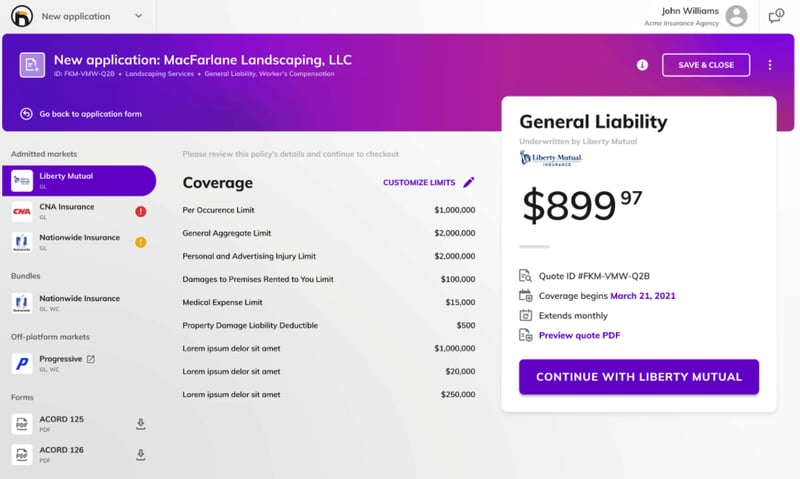
BOLD PENGUIN X CENSUS
How Bold Penguin reduced support response times from 24 hours to 30 minutes with operational Slack alerts
With easier access to customer and product data, Bold Penguin created automatic alerts that enabled its Customer Success team to act quickly on common issues, reducing response times by 98%.
Industry: Insurance
Headquarters: Columbus, Ohio
Company type: B2B
Team: Customer Success
Use cases: Real-time alerts
Featured integrations: Google Sheets, Intercom, Redshift, Salesforce, Slack
Bold Penguin is an insurtech company supporting commercial insurance carriers and agents. They offer a quoting platform paired with a commercial insurance exchange that helps agents match businesses with “the right quote in record time.”
At Bold Penguin, the Business Intelligence (BI) unit supports teams like Marketing and Customer Success by getting them the data they need to operate effectively. As their company grew, they needed efficient ways to move and manipulate data. The company, which aims to reduce friction in procuring commercial insurance, was experiencing significant friction with making their data accessible to the teams who needed it.
Results
-
Reduced support response time for partner issues from days to minutes
-
Allowed business analysts outside the BI team to set up their own data connections
-
Automated marketing segmentation to enable targeted campaigns
“We’ve been able to train folks who traditionally would write out a request form, send it to the BI team, and wait a few days to get their data. Now we’ve got analysts outside of the BI team, folks who aren’t comfortable writing code or merging changes into our BI repo, that can set up their own connections to feed their operations tools out of our warehouse.”
Eric Bloedorn, Director of Product Management
The Challenge
Building a resilient data pipeline
The BI team at Bold Penguin was spending too much time maintaining tooling to move data out of their warehouse. Changes happened frequently on both their warehouse and operational tools, so they frequently needed to update configuration on both sides of the flow.
This left the Bold Penguin team with some challenges:
- Maintaining custom scripts was cumbersome, and diverting precious BI resources from other projects.
- Business users frequently had to request updates to get the latest metrics in their tool of choice.
- Teams were slowed down by processing their data manually – such as manually tagging customer segments in Intercom.

“We were just spending too much time maintaining custom code to move data out of the warehouse and into our tools, eating up valuable BI time. Then we found Census.”
Eric Bloedorn
Director of Product Management
The Decision Criteria: Why did Bold Penguin choose Census?
Easy implementation
Bold Penguin’s BI team needed to get rolling without a big implementation project. They found that Census was easy enough to set up that they could do it themselves, quickly.
“If you are comfortable writing SQL, you’re up and running the same day.”
Eric Bloedorn, Director of Product Management
Accessible for teams outside of BI
It was important to the BI team that other groups be able to access data and set up new connections themselves. They’d seen requests to their team become a bottleneck and wanted data access to be as self-serve as possible.
JustWorks™
Bold Penguin values that Census “just works” for them, especially since they are trusting Census to sync business critical data to teams who depend on it. “We've asked for a couple of feature enhancements here and there, but it just works with almost no support,” says Eric.
“We rely on Fivetran to get our data into the warehouse. Census fits like a glove on the other end of the flow.”
Eric Bloedorn, Director of Product Management
Fair pricing for mid-sized companies
The pricing for other tools didn’t work for a mid-sized company like Bold Penguin. They weren’t quite big enough for enterprise pricing to make sense, but needed more seats and connectors than were available with non-enterprise plans.
Census’ pricing was “very fair” and enabled Bold Penguin to get started and grow without getting a giant bill at some arbitrary breakpoint.
The Solutions
Creating timely alerts for Sales and Success
When a client doesn’t get a perfect outcome on the Bold Penguin platform, the Customer Success & Sales teams needs to act quickly.
Before using Census, the Sales team relied on a weekly report from Stripe to find out about a subscription renewal issue or incomplete invoice. Bold Penguin’s Product team has been able to set up live operational alerts in Slack based on logs in the data warehouse. Now, when a payment fails, account managers automatically receive a Slack notification so they can follow up and resolve the issue.
It wasn’t just the Sales team that benefited. Customer Success also gets an alert for Agent Terminal errors. By finding and resolving issues in near real time, Bold Penguin is able to ensure top notch customer satisfaction.
Targeting marketing campaigns for different verticals
Bold Penguin serves clients across many different verticals – the audience for Cyber insurance isn’t the same as Commercial Auto. By syncing product usage and partner data to enrich user profiles, they can create targeted marketing campaigns that resonate with specific types of clients.
Segmenting users based on product usage
Pulling together product usage data from both their insurance quoting platform and their insurance Exchange, Bold Penguin is able to segment users based on their level of activity and the type of business they’re doing. Feeding those insights to Intercom allows them to send more relevant content and messaging to users. Eric explains, "You can go into our Intercom instance and say ‘for people with this level of activity, let's send this content. And people below that threshold are going to get different content. Census enables us to easily vary content across a variety of factors.”
The Outcomes
Cut support times from 24 hours to 30 minutes
As Bold Penguin scaled its Agent Terminal platform, getting accurate data to Customer Success quickly became critical. Some issues could take up to 24 hours to resolve, and much of that time was not having the right data, in the right hands, at the right time. With operational Slack alerts to team members, Bold Penguin has cut that response time to just 30 minutes.
Reduced ‘time to insight’ and made data more accessible
Business users can now set up their own data connections, feeding data from the warehouse into their tools. With self-serve data, they no longer need to wait for someone to build them a connection, reducing the time before they can take action on that data. And with Census, business users can adapt their processes to new datasets on the fly.
“We’ve seen our ratio of support cases to customer drop, and our average response time drop pretty substantially.”
Eric Bloedorn, Director of Product Management
Fully automated user segmentation for Marketing
With user segmentation done automatically using SQL, there’s no more tedious manual data entry or cleanup. The Marketing team is freed up to focus on campaigns, not tagging customer records in a CRM.
“People were manually marking hundreds of customers as Group A, Group B, etc. Those customers are now tagged as their behavior changes and automatically segmented. No one has to touch anything. That’s been a huge time saver for us.”
Eric Bloedorn, Director of Product Management
From your data warehouse to all your apps, customers, and agents.
Without code or CSVs.
Start using Census today by booking a demo with one of our experts.
















